Evaluation of the Impact of Bricks of Various Characteristics on Internally Insulated Masonry Walls in Cold Climate
Abstract
:1. Introduction
2. Methodology
3. Results
3.1. Hygrothermal Behavior of Masonry with Capillary-Active Insulation without the Adhesive Glue
3.2. Hygrothermal Behavior of Masonry with Capillary-Active Insulation with the Adhesive Glue
4. Discussion
5. Conclusions
- Temperature trends display practically no influences by brick type;
- Brick type has a noticeable impact on the hygrothermal behavior of the insulated masonry wall;
- There are no correlations between individual brick parameters and moisture dynamics within brick samples;
- Capillary-active internal insulation use in cold climate is safe as long the indoor relative humidity does not exceed 65% in warm months and 35% in cold months;
- The application of adhesive glue tends to reduce moisture spikes caused by rain events when compared to the same samples without adhesive.
Author Contributions
Funding
Conflicts of Interest
Appendix A
| Sample ID | Density [kg/m3] | Heat Capacity [J/kgK] | Heat Conductivity [W/mK] | Porosity [m3/m3] | Capillary Saturation [m3/m3] | Water Vapor Resistance Factor [-] | Water Uptake [kg/m2s0.5] | Liquid Water Conductivity [s] |
| 18_4 | 1777.3 | 1181.0 | 2.739 | 0.304 | 0.198 | 18.37 | 0.104 | 1.00 × 10−10 |
| 18_5 | 1516.4 | 1107.2 | 0.726 | 0.414 | 0.268 | 14.84 | 0.473 | 5.00 × 10−9 |
| 18_6 | 1580.5 | 994.4 | 0.636 | 0.385 | 0.239 | 8.33 | 0.257 | 1.00 × 10−10 |
| 18_7 | 1641.1 | 899.2 | 0.395 | 0.345 | 0.263 | 8.06 | 0.338 | 1.00 × 10−10 |
| 18_15 | 1831.3 | 873.9 | 0.626 | 0.380 | 0.308 | 15.42 | 0.369 | 1.00 × 10−8 |
| 18_16 | 1828.9 | 852.5 | 0.527 | 0.289 | 0.154 | 13.52 | 0.092 | 1.00 × 10−9 |
| 19_1 | 1496.9 | 1010.1 | 0.686 | 0.427 | 0.387 | 6.82 | 0.744 | 1.00 × 10−8 |
| 19_2 | 1572.4 | 1023.1 | 0.645 | 0.451 | 0.441 | 10.38 | 0.735 | 1.00 × 100 |
| 19_4 | 1761.9 | 872.1 | 0.411 | 0.297 | 0.216 | 16.49 | 0.158 | 1.00 × 10−8 |
| 19_5 | 1526.0 | 1024.5 | 0.545 | 0.408 | 0.384 | 7.08 | 0.786 | 1.00 × 10−9 |
| 19_6 | 1781.8 | 845.4 | 0.498 | 0.304 | 0.233 | 8.10 | 0.202 | 1.00 × 10−10 |
| 19_7 | 2118.3 | 857.9 | 1.361 | 0.166 | 0.077 | 18.06 | 0.013 | 1.00 × 10−9 |
| 19_8 | 1678.1 | 939.8 | 0.527 | 0.348 | 0.232 | 14.53 | 0.182 | 1.00 × 10−10 |
| 19_9 | 1656.2 | 960.7 | 0.553 | 0.370 | 0.280 | 17.09 | 0.100 | 1.00 × 10−6 |
| 19_10 | 1904.9 | 766.8 | 1.037 | 0.263 | 0.166 | 17.39 | 0.116 | 1.00 × 10−7 |
| 19_11 | 1664.6 | 805.0 | 0.387 | 0.410 | 0.319 | 9.86 | 0.339 | 1.00 × 10−10 |
| 19_12 | 1718.1 | 907.0 | 0.637 | 0.306 | 0.276 | 13.86 | 0.219 | 1.00 × 10−8 |
| 19_13 | 1919.9 | 724.0 | 0.763 | 0.265 | 0.215 | 19.68 | 0.187 | 1.00 × 10−8 |
| 19_14 | 1891.1 | 828.2 | 0.605 | 0.263 | 0.226 | 34.75 | 0.125 | 1.00 × 10−9 |
| 19_15 | 1844.4 | 814.8 | 1.042 | 0.292 | 0.225 | 14.42 | 0.165 | 1.00 × 10−6 |
| 19_16 | 1757.2 | 982.6 | 0.691 | 0.331 | 0.275 | 16.56 | 0.181 | 1.00 × 10−9 |
| 19_17 | 1941.6 | 762.5 | 1.074 | 0.247 | 0.192 | 35.29 | 0.028 | 1.00 × 10−9 |
| 19_18 | 1731.3 | 810.3 | 0.662 | 0.364 | 0.223 | 50.19 | 0.184 | 1.00 × 10−9 |
| 20_1 | 1800.0 | 783.3 | 0.496 | 0.308 | 0.227 | 16.97 | 0.137 | 1.00 × 10−6 |
| 20_2 | 1931.7 | 759.0 | 0.627 | 0.266 | 0.214 | 23.58 | 0.179 | 1.00 × 10−9 |
| 20_3 | 1887.5 | 849.4 | 1.026 | 0.253 | 0.218 | 34.93 | 0.049 | 1.00 × 10−9 |
| 20_4 | 1969.4 | 802.2 | 0.814 | 0.237 | 0.147 | 40.55 | 0.095 | 1.00 × 10−7 |
| 20_5 | 1920.3 | 783.5 | 0.690 | 0.278 | 0.212 | 14.80 | 0.139 | 1.00 × 10−9 |
| 20_6 | 2116.6 | 732.3 | 0.878 | 0.202 | 0.160 | 12.77 | 0.117 | 1.00 × 10−9 |
| 20_7 | 1932.2 | 823.0 | 0.742 | 0.269 | 0.220 | 11.94 | 0.201 | 1.00 × 10−10 |
| 20_8 | 1688.6 | 902.9 | 0.554 | 0.337 | 0.273 | 11.36 | 0.170 | 1.00 × 10−9 |
| 20_9 | 1500.4 | 1011.8 | 0.542 | 0.438 | 0.356 | 6.79 | 0.544 | 1.00 × 10−9 |
| 20_10 | 1685.9 | 941.4 | 0.536 | 0.362 | 0.282 | 10.88 | 0.312 | 1.00 × 10−9 |
| 20_11 | 1862.6 | 820.5 | 0.602 | 0.281 | 0.181 | 19.59 | 0.091 | 1.00 × 10−9 |
| 20_12 | 1954.1 | 787.1 | 0.558 | 0.255 | 0.232 | 21.69 | 0.159 | 1.00 × 10−6 |
| 20_13 | 1886.5 | 793.4 | 0.695 | 0.267 | 0.177 | 23.85 | 0.171 | 1.00 × 10−9 |
| 20_14 | 1755.2 | 874.2 | 0.617 | 0.295 | 0.251 | 14.38 | 0.166 | 1.00 × 10−9 |
| 20_15 | 1623.5 | 998.8 | 0.602 | 0.279 | 0.196 | 16.42 | 0.123 | 1.00 × 10−9 |
| 20_16 | 1846.1 | 878.3 | 0.602 | 0.226 | 0.149 | 33.87 | 0.111 | 1.00 × 10−9 |
| 20_18 | 1787.6 | 851.0 | 0.552 | 0.325 | 0.266 | 10.97 | 0.235 | 1.00 × 10−9 |
References
- Adhikari, R.; Lucchi, E.; Pracchi, V. Experimental Measurements on Thermal Transmittance of the Opaque Vertical Walls in the Historical Buildings. In Proceedings of the PLEA 2012—28th Conference. Opportunities, Limits & Needs towards an Environmentally Responsible Architecture, Lima, Peru, 7–9 November 2012; Reiser, J., Jiménez, C., Biondi Antúnez de Mayolo, S., Eds.; pp. 1248–1256. [Google Scholar]
- De Mets, T.; Tilmans, A.; Loncour, X. Hygrothermal assessment of internal insulation systems of brick walls through numerical simulation and full-scale laboratory testing. Energy Procedia 2017, 132, 753–758. [Google Scholar] [CrossRef]
- Franzoni, E. Rising damp removal from historical masonries: A still open challenge. Constr. Build. Mater. 2014, 54, 123–136. [Google Scholar] [CrossRef]
- Feng, C.; Janssen, H. Hygric properties of porous building materials (IV): Semi-permeable membrane and psychrometer methods for measuring moisture storage curves. Build. Environ. 2019, 152, 39–49. [Google Scholar] [CrossRef]
- Zhou, M.; Li, X.; Feng, C.; Janssen, H. Hygric properties of porous building materials (VIII): Influence of reduced air pressure. Build. Environ. 2022, 225, 109680. [Google Scholar] [CrossRef]
- Oumeziane, Y.A.; Pierre, A.; El Mankibi, F.; Lepiller, V.; Gasnier, M.; Désévaux, P. Hygrothermal properties of an early 20th century clay brick from eastern France: Experimental characterization and numerical modelling. Constr. Build. Mater. 2021, 273, 121763. [Google Scholar] [CrossRef]
- Zhou, X.; Carmeliet, J.; Derome, D. Assessment of risk of freeze-thaw damage in internally insulated masonry in a changing climate. Build. Environ. 2020, 175, 106773. [Google Scholar] [CrossRef]
- Calle, K.; Van Den Bossche, N. Sensitivity of the hygrothermal behaviour of homogeneous masonry constructions: From Sobol indices to decision trees. E3S Web Conf. 2020, 172, 07001. [Google Scholar] [CrossRef]
- Larsen, P.K. Moisture Physical Properties of Bricks: An Investigation of Falkenløwe, Stralsund and Hartmann Bricks; Report; Technical University of Denmark, Department of Civil Engineering: Lyngby, Denmark, 1995. [Google Scholar]
- Vanderschelden, B.; Calle, K.; Van Den Bossche, N. On the potential of clustering approaches for hygrothermal material properties based on three degradation risks in solid masonry constructions. J. Build. Phys. 2022, 46, 36–76. [Google Scholar] [CrossRef]
- Zhao, J.; Plagge, R.; Ramos, N.M.; Simões, M.L.; Grunewald, J. Application of clustering technique for definition of generic objects in a material database. J. Build. Phys. 2015, 39, 124–146. [Google Scholar] [CrossRef]
- Mensinga, P.; Straube, J.; Schumacher, C. Assessing the freeze-thaw resistance of clay brick for interior insulation retrofit projects. In Proceedings of the XI International Conference Thermal Performance of the Exterior Envelopes of Whole Buildings, Clearwater, FL, USA, 15 December 2010. [Google Scholar]
- Zhou, X.; Carmeliet, J.; Derome, D. Influence of envelope properties on interior insulation solutions for masonry walls. Build. Environ. 2018, 135, 246–256. [Google Scholar] [CrossRef]
- Feng, C.; Janssen, H. Hygric properties of porous building materials (VII): Full-range benchmark characterizations of three materials. Build. Environ. 2021, 195, 107727. [Google Scholar] [CrossRef]
- Hirsch, H.; Heyn, R.; Klõšeiko, P. Capillary condensation experiment for inverse modelling of porous building materials. E3S Web Conf. 2020, 172, 17003. [Google Scholar] [CrossRef]
- Bottino-Leone, D.; Larcher, M.; Troi, A.; Grunewald, J. Impact of climatic parameters on rain protection layer design for refurbished historic buildings. Renew. Sustain. Energy Rev. 2021, 152, 111688. [Google Scholar] [CrossRef]
- Häupl, P.; Fechner, H. Hygric Material Properties of Porous Building Materials. J. Therm. Envel. Build. Sci. 2003, 26, 259–284. [Google Scholar] [CrossRef]
- Grunewald, J.; Ruisinger, U.; Häupl, P. The Rijksmuseum Amsterdam—Hygrothermal analysis and dimensioning of thermal insulation. In Research in Building Physics and Building Engineering; CRC Press: Boca Raton, FL, USA, 2006; pp. 345–352. [Google Scholar]
- Vereecken, E.; Roels, S. A comparison of the hygric performance of interior insulation systems: A hot box–cold box experiment. Energy Build. 2014, 80, 37–44. [Google Scholar] [CrossRef]
- Scheffler, G.; Grunewald, J. Material development and optimisation supported by numerical simulation for a capillary-active inside insulation material. Res. Build. Phys. 2003. In Proceedings of the Second International Conference on Building Physics, Leuven, Belgium, 14–18 September 2003; pp. 77–85. [Google Scholar]
- Vereecken, E.; Roels, S. Capillary active interior insulation: Do the advantages really offset potential disadvantages? Mater. Struct. 2015, 48, 3009–3021. [Google Scholar] [CrossRef]
- Vereecken, E.; Roels, S. Capillary Active Interior Insulation Systems for Wall Retrofitting: A More Nuanced Story. Int. J. Archit. Herit. 2016, 10, 558–569. [Google Scholar] [CrossRef]
- Antolinc, D.; Černe, K.; Jagličić, Z. Risk of Using Capillary Active Interior Insulation in a Cold Climate. Energies 2021, 14, 6890. [Google Scholar] [CrossRef]
- Freimanis, R.; Blumberga, A.; Zundans, Z.; Balins, R.; Vanaga, R. Hygrothermal Properties of Historic Bricks from Various Sites of Latvia; Rigas Tehniska Universitate: Riga, Latvia, 2021. [Google Scholar] [CrossRef]
- Freimanis, R.; Zundans, Z.; Balins, R.; Vanaga, R.; Blumberga, A. Finding the Generic Hygrothermal Properties of Historical Bricks by Supervised Agglomerative Clustering. Environ. Clim. Technol. 2022, 26, 1234–1243. [Google Scholar] [CrossRef]
- Latvijas Vides, Ģeoloģijas un Meteoroloģijas Centrs. Available online: https://videscentrs.lv (accessed on 6 September 2023).
- Zhao, J.; Feng, S.; Grunewald, J.; Meissner, F.; Wang, J. Drying characteristics of two capillary porous building materials: Calcium silicate and ceramic brick. Build. Environ. 2022, 216, 109006. [Google Scholar] [CrossRef]
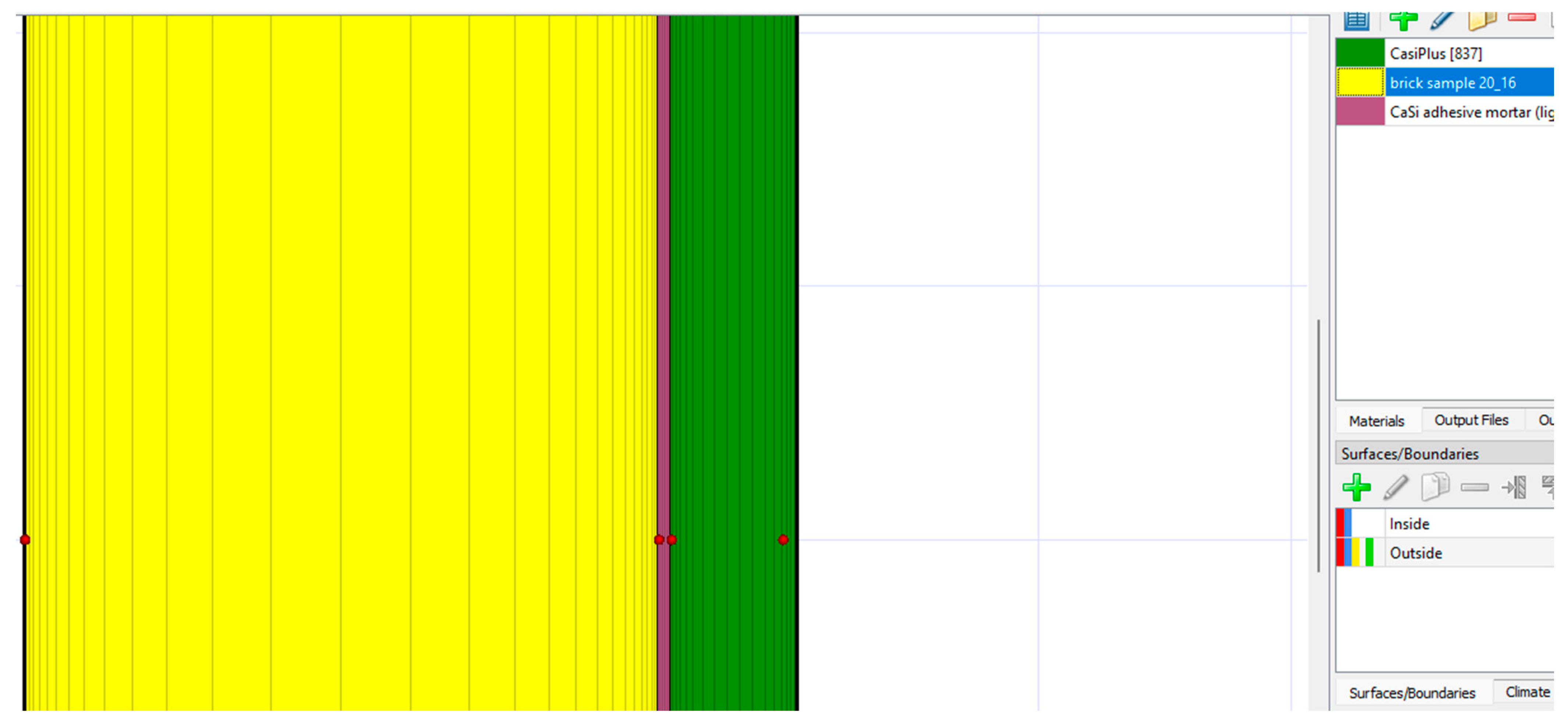
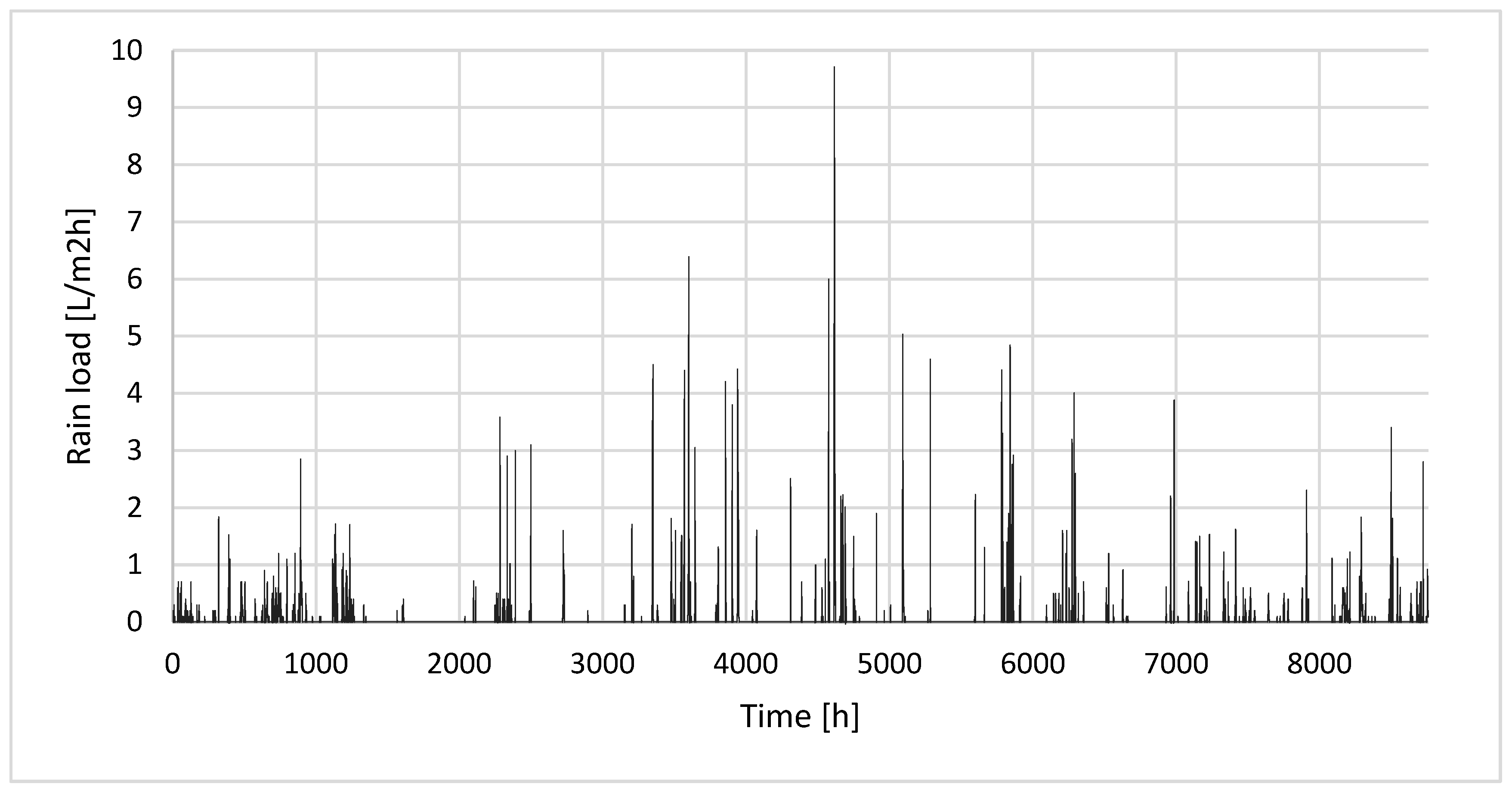
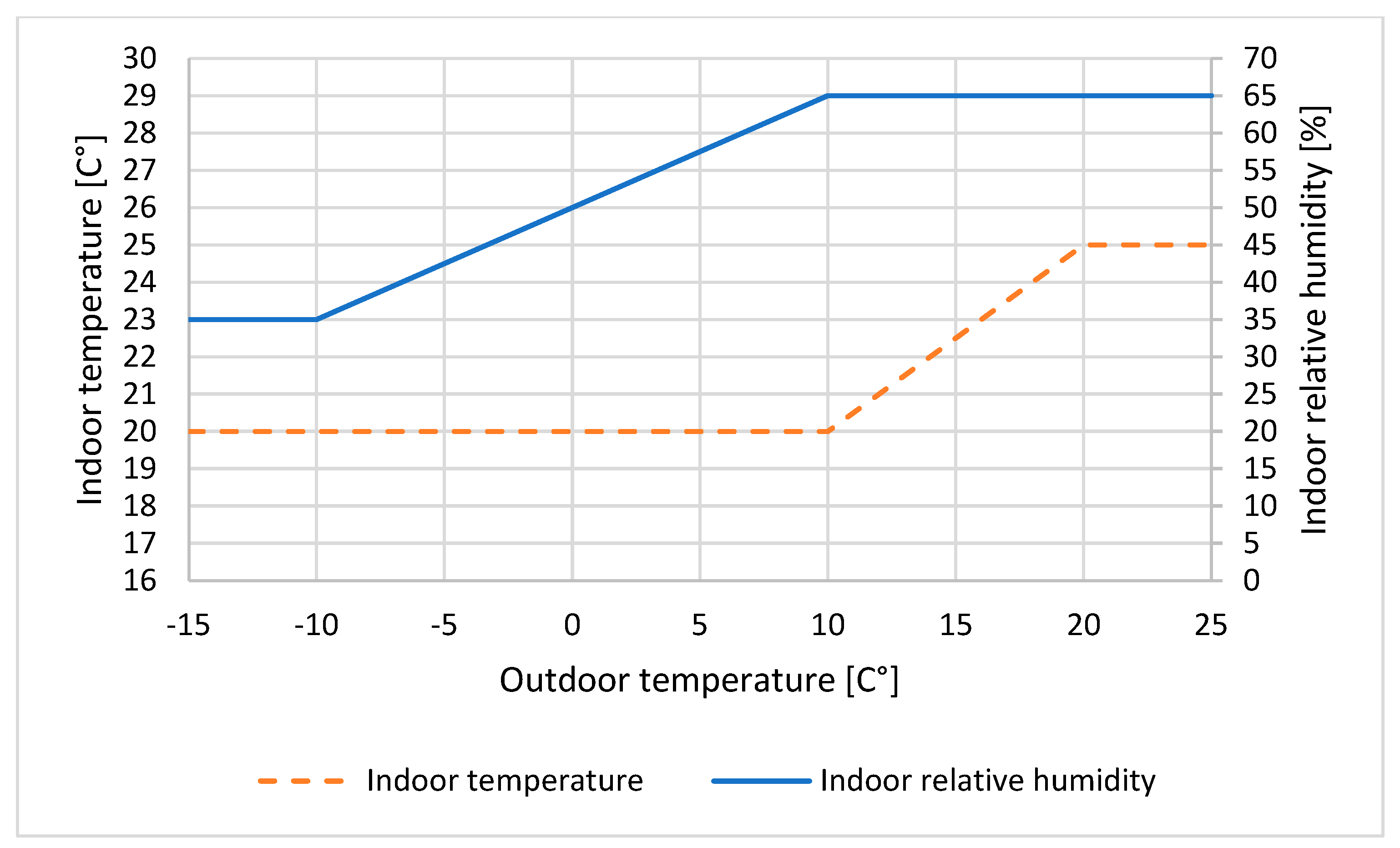
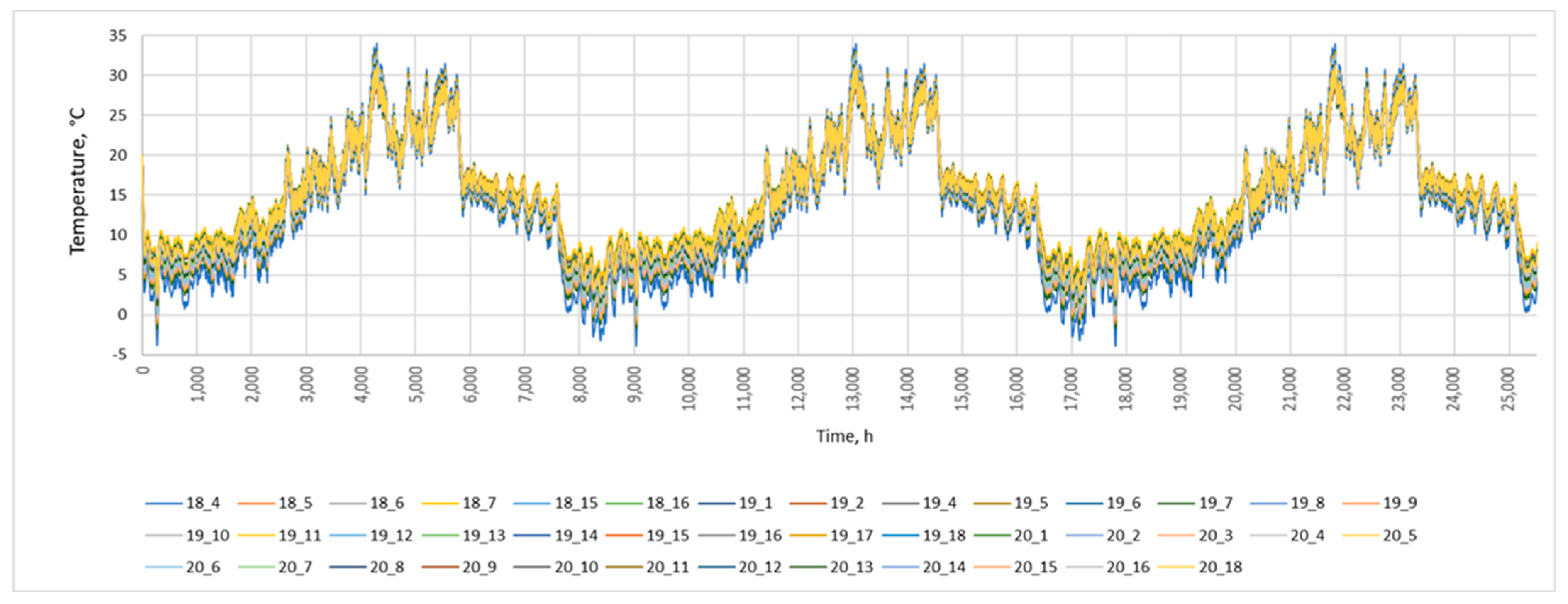
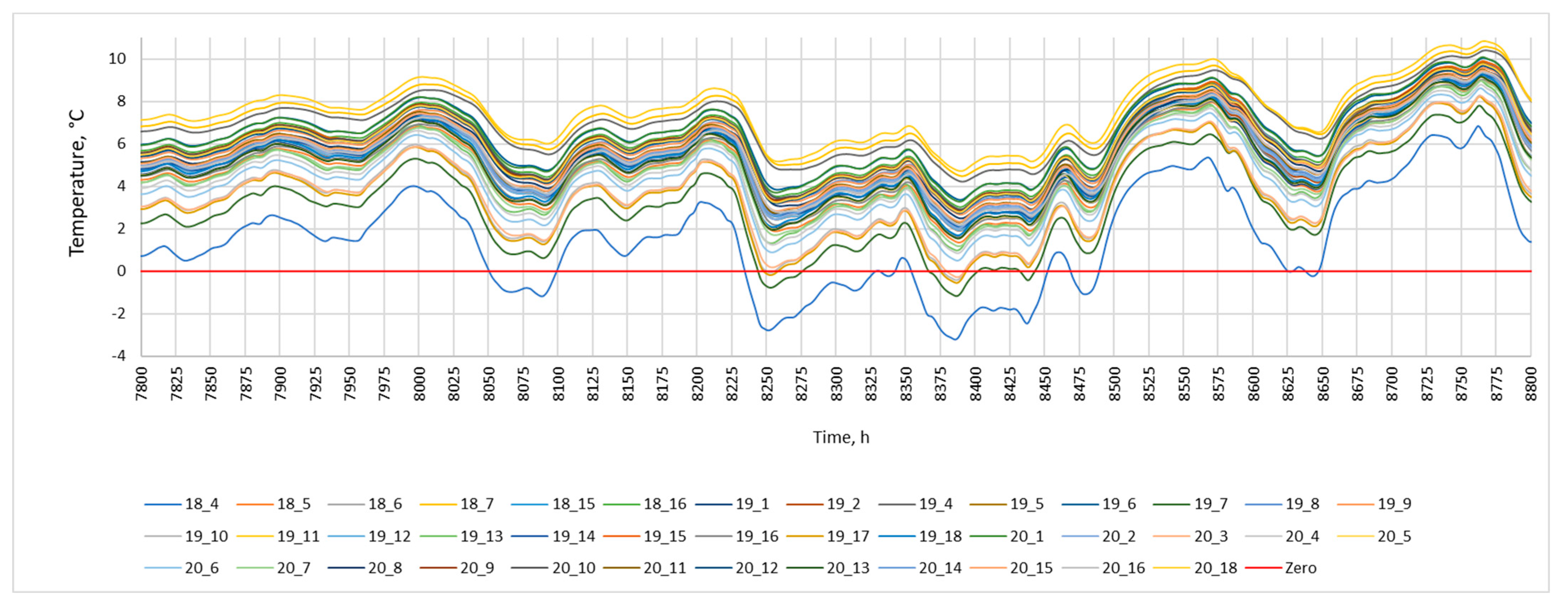
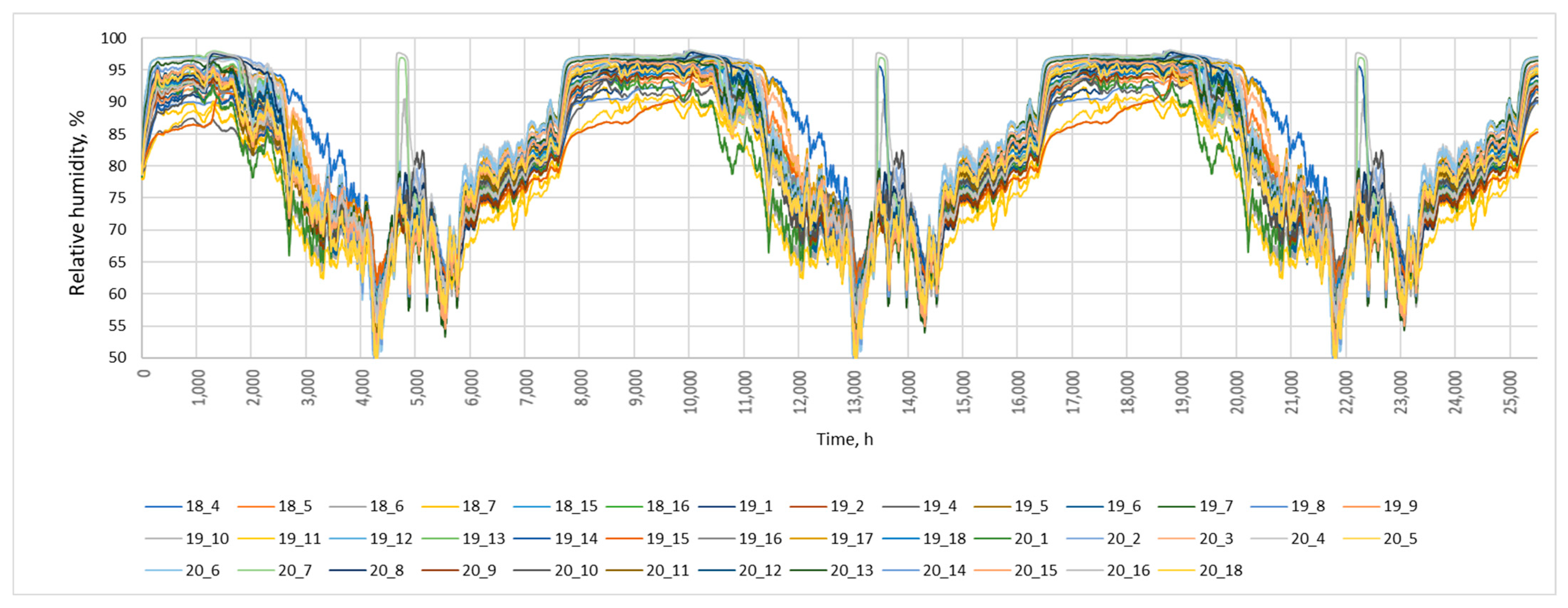
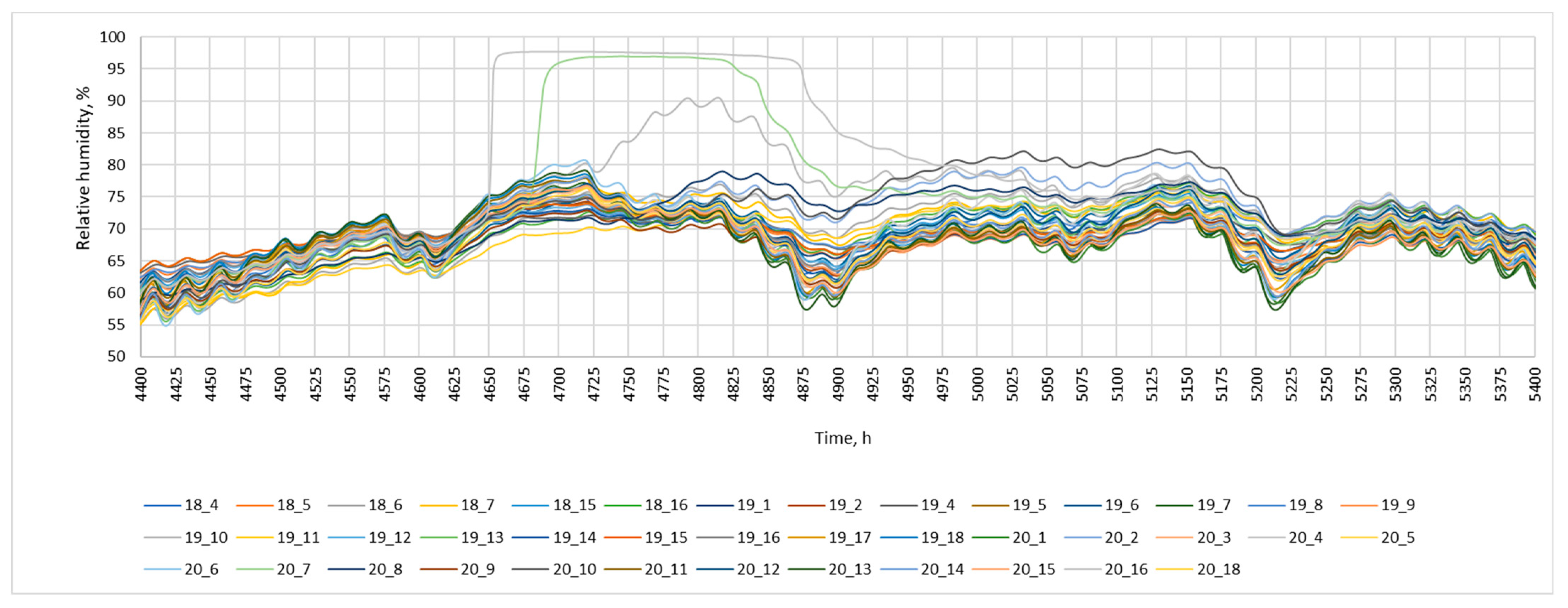
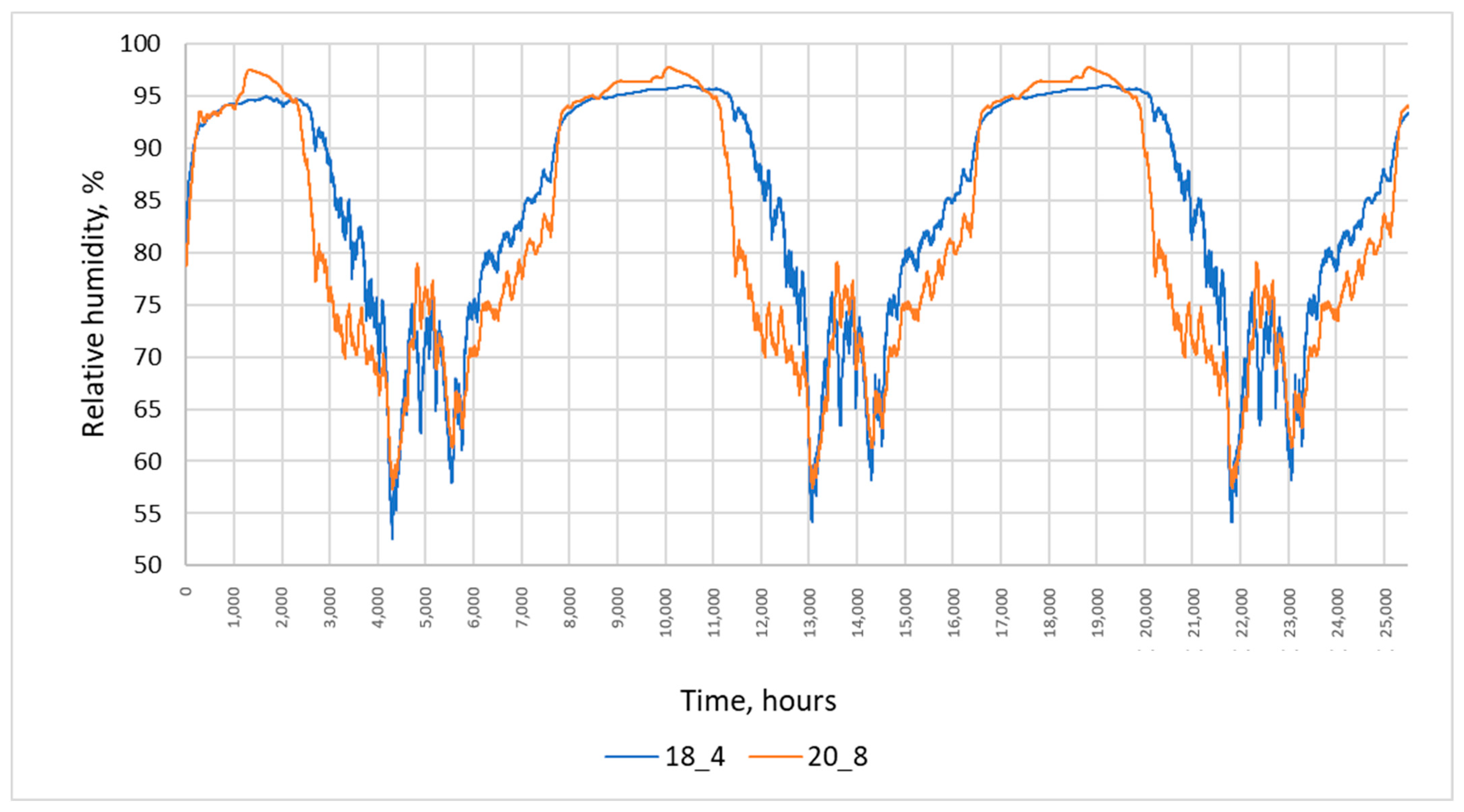
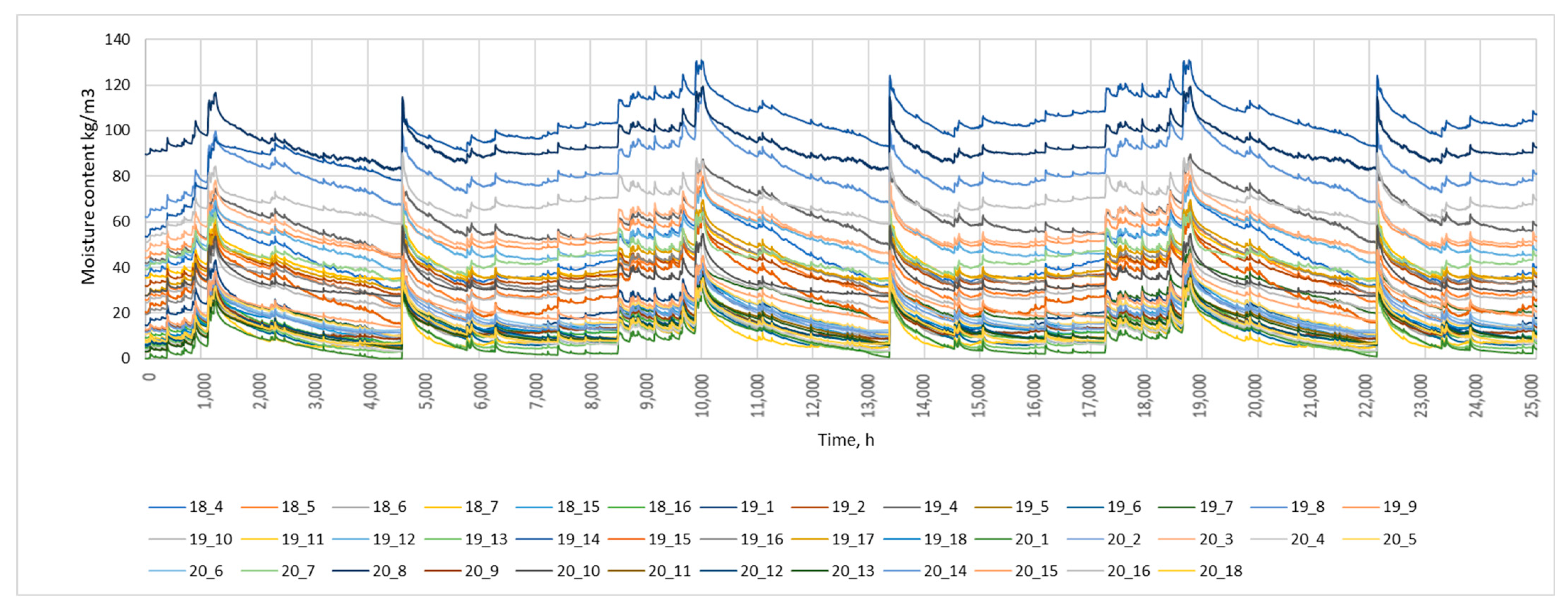
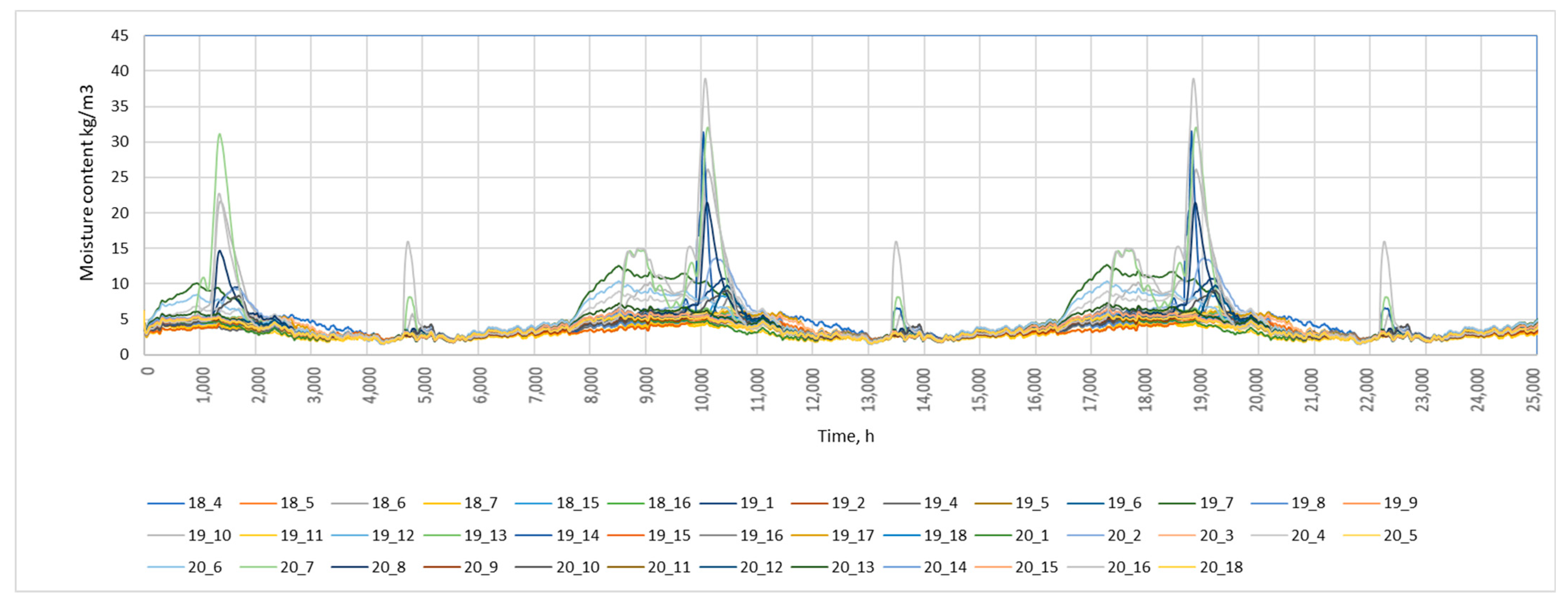

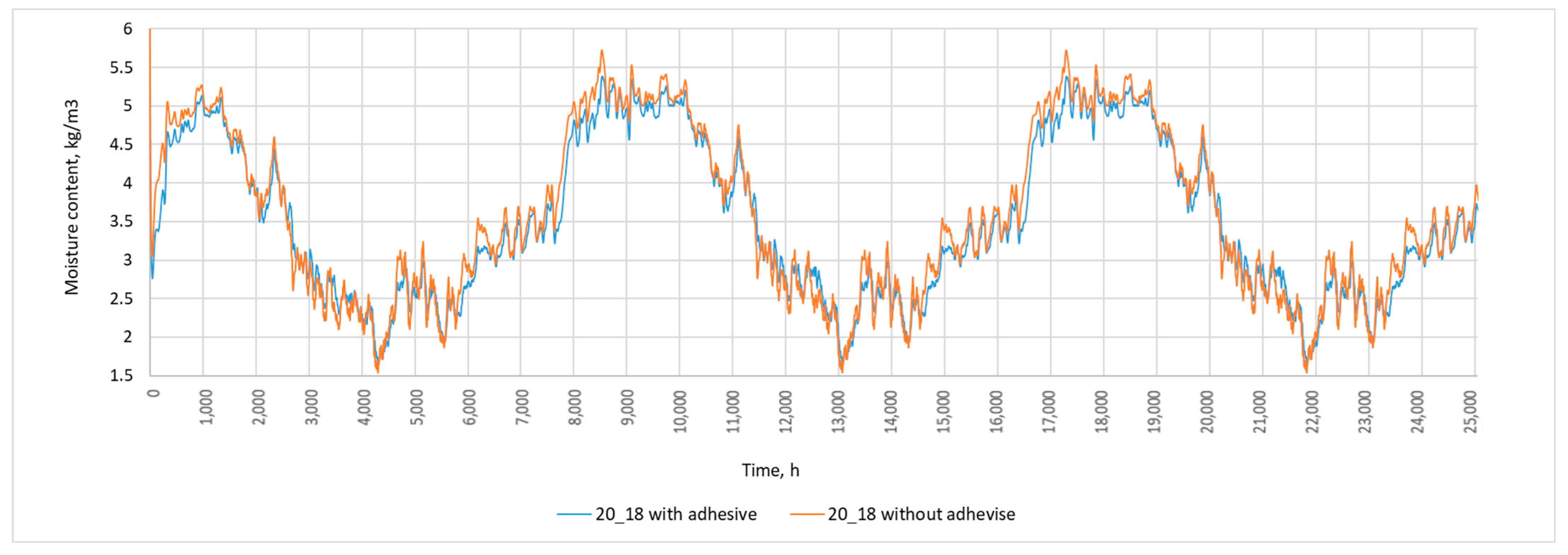
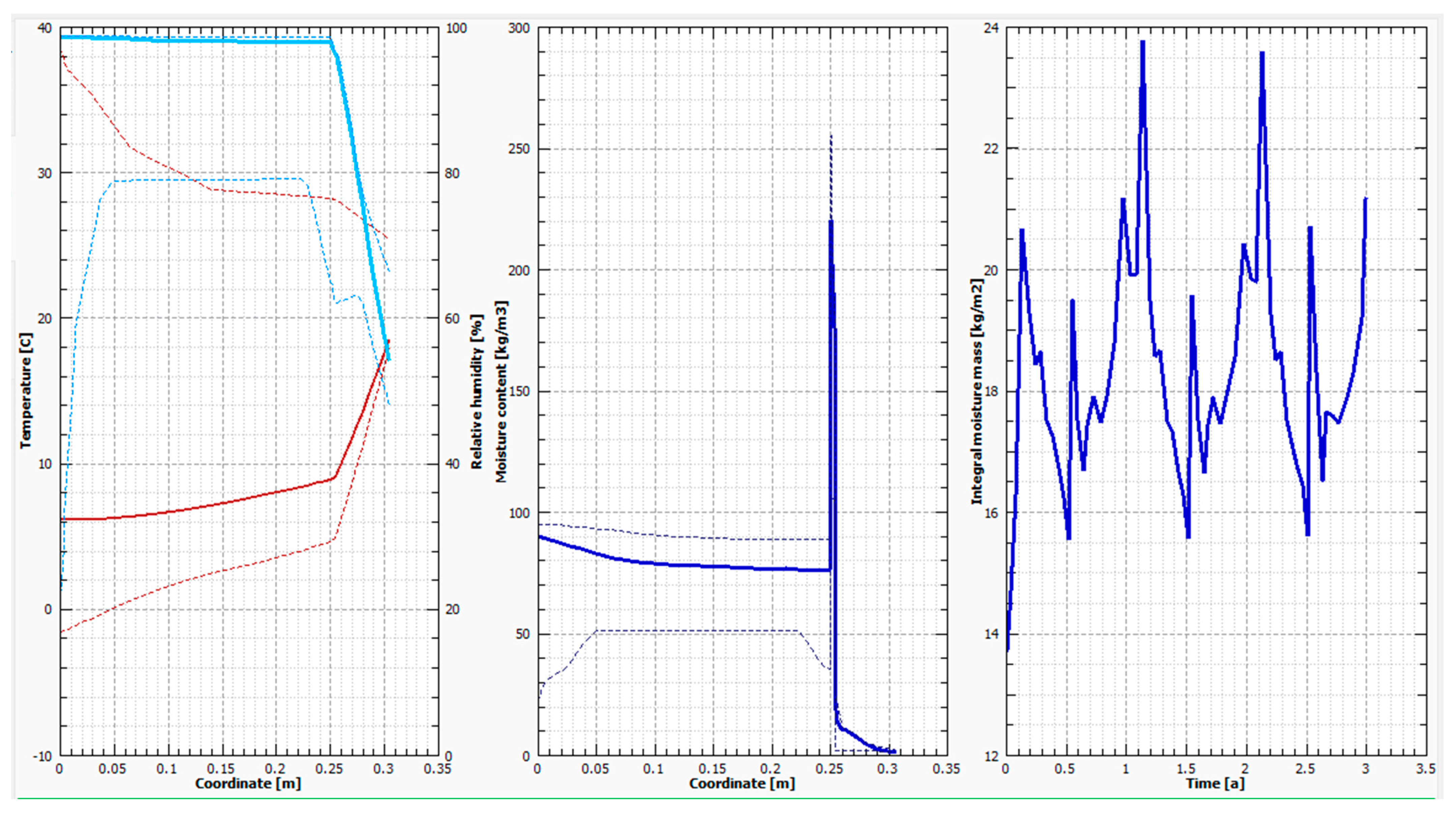
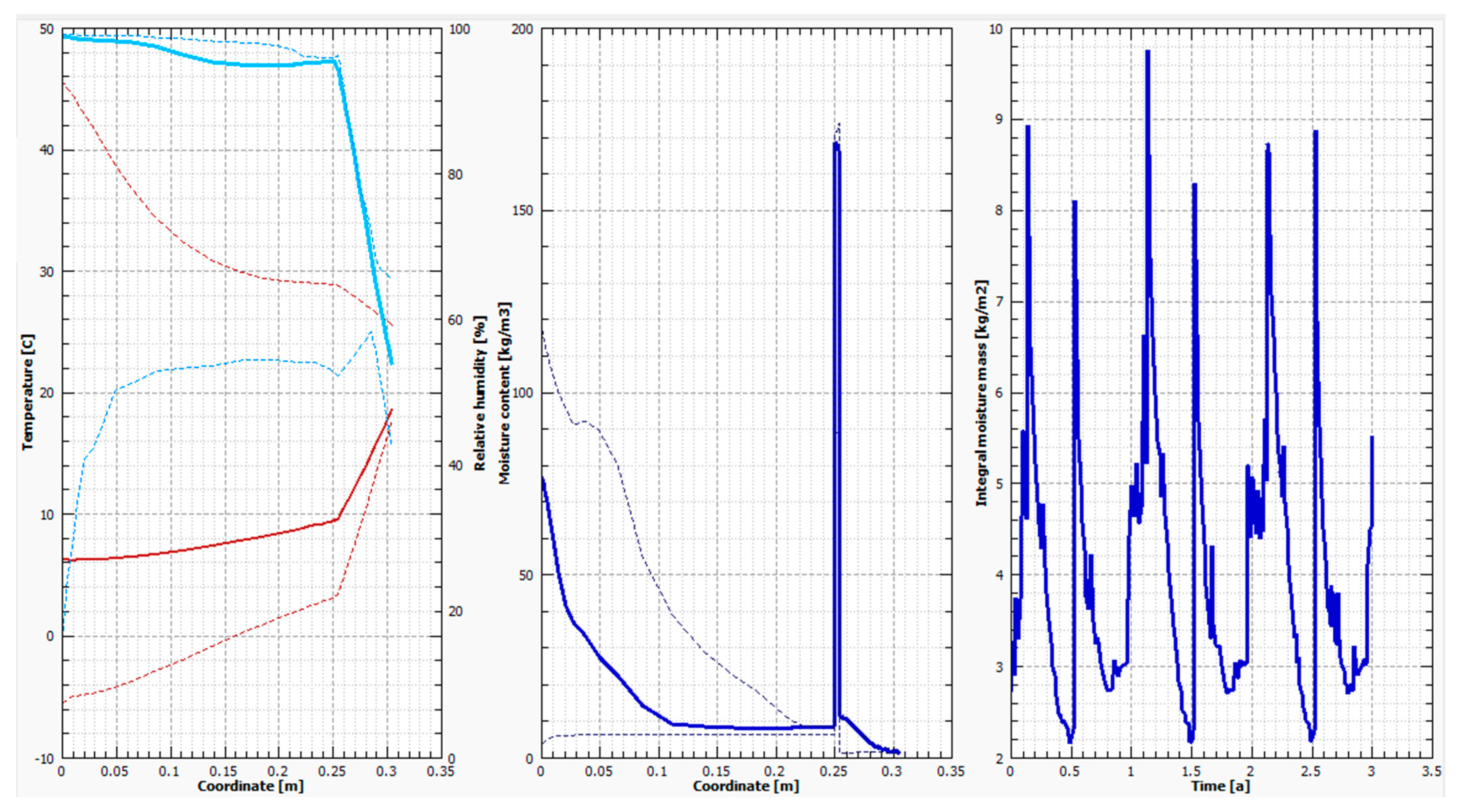
| Parameter | Calcium Silicate | Adhesive (Glue) | Unit |
|---|---|---|---|
| Bulk density | 225.04 | 820.033 | kg/m3 |
| Specific heat capacity | 1129 | 1306.5 | J/kgK |
| Open porosity | 0.9136 | 0.690553 | m3/m3 |
| Effective saturation | 0.90408 | 0.34 | m3/m3 |
| Capillary saturation | 0.7211 | 0.316 | m3/m3 |
| Hygroscopic sorption value at 80% relative humidity | 0.00622307 | 0.139355 | m3/m3 |
| Thermal conductivity | 0.061 | 0.216 | W/mK |
| Water uptake coefficient | 0.7831 | 0.00801211 | kg/m2s0.5 |
| Water vapor diffusion resistance factor | 2.3973 | 18.9365 | - |
| Liquid water conductivity | 3.08745 × 10−10 | 6.80328 × 10−12 | s |
Disclaimer/Publisher’s Note: The statements, opinions and data contained in all publications are solely those of the individual author(s) and contributor(s) and not of MDPI and/or the editor(s). MDPI and/or the editor(s) disclaim responsibility for any injury to people or property resulting from any ideas, methods, instructions or products referred to in the content. |
© 2023 by the authors. Licensee MDPI, Basel, Switzerland. This article is an open access article distributed under the terms and conditions of the Creative Commons Attribution (CC BY) license (https://creativecommons.org/licenses/by/4.0/).
Share and Cite
Freimanis, R.; Blumberga, A.; Vanaga, R.; Zundāns, Z. Evaluation of the Impact of Bricks of Various Characteristics on Internally Insulated Masonry Walls in Cold Climate. Buildings 2023, 13, 2529. https://doi.org/10.3390/buildings13102529
Freimanis R, Blumberga A, Vanaga R, Zundāns Z. Evaluation of the Impact of Bricks of Various Characteristics on Internally Insulated Masonry Walls in Cold Climate. Buildings. 2023; 13(10):2529. https://doi.org/10.3390/buildings13102529
Chicago/Turabian StyleFreimanis, Ritvars, Andra Blumberga, Ruta Vanaga, and Zigmārs Zundāns. 2023. "Evaluation of the Impact of Bricks of Various Characteristics on Internally Insulated Masonry Walls in Cold Climate" Buildings 13, no. 10: 2529. https://doi.org/10.3390/buildings13102529
APA StyleFreimanis, R., Blumberga, A., Vanaga, R., & Zundāns, Z. (2023). Evaluation of the Impact of Bricks of Various Characteristics on Internally Insulated Masonry Walls in Cold Climate. Buildings, 13(10), 2529. https://doi.org/10.3390/buildings13102529






